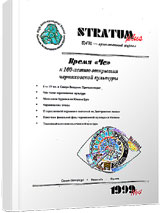Черняховский могильник Курники на Южном Буге
The Chernyakhov cemeteries Kurniki on South Boug
Author(s): Boris V. MagomedovSubject(s): History, Archaeology, Social history, Ancient World
Published by: Издательский дом Stratum, Университет «Высшая антропологическая школа»
Summary/Abstract: The cemetery is located close to the village of Kurniki (Tyvrov region, Vinnitza oblast) and is connected with the partially investigated settlement (fig. 1). The cemetery is investigated practically completely (fig. 2). On the northern site of it there are almost no finds in a layer; all burial places with inhumation are concentrated here (fig. 3-13; 14:3-6). On the southern site three cult holes are found, there are the calcined bones in the layer, also the fragments of burnt ceramics and others are present (fig. 14:1,2; 15). Presumably there was located the site with cremations, but it was destroyed by ploughing. Fourteen inhumations among the total number of twenty-seven are directed to the north, thirteen - to the west. The burial No 18, apparently, is the cenotaph. 13 graves have steps, the wooden ceilings are leant on them. Western orientation, the holes with the steps, and also the tradition to coat the bottom of the hole beneath the deceased with the green clay (burial No 3) point to the presence of Late Scythian ethnic element. The custom of the northern orientation of the deceased put into the simple holes (more than 80 % on chernyakhov cemeteries), and also the tradition of the cremation belongs mainly to German-Goths. Destroyed burials No 4, 14 and 19 are marked by its size and depth, there are valuable things kept in them. The similar graves of the aristocracy are connected with the German cultures of Central Europe. It is sensible to restrict the period of functioning of the cemetery to the second half of the 4th century, though it is possible that the last burial took place at the beginning of the 5 century (for example No 26). Probably the cemetery belonged to one clan of the entatives local nobility, including the dependent people. Apart from the features of the burial customs, the ethnic belonging of the population is defined by the hand-made ceramics from a settlement. It belongs to Wielbark culture, which is connected with the tribe of the Goths. The people buried at the cemetery had the mixed origin. Except for the Germanics, there were the Late Scythians from the Black Sea area.
Journal: Stratum plus. Археология и культурная антропология
- Issue Year: 1999
- Issue No: 4
- Page Range: 102-120
- Page Count: 19
- Language: Russian

